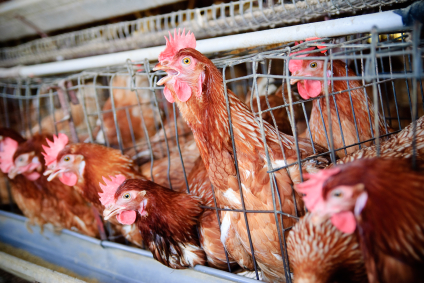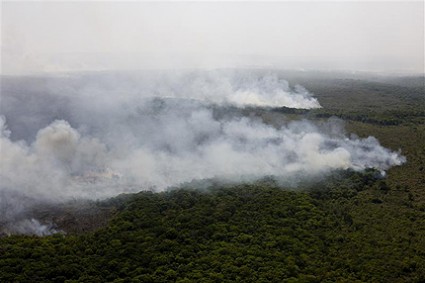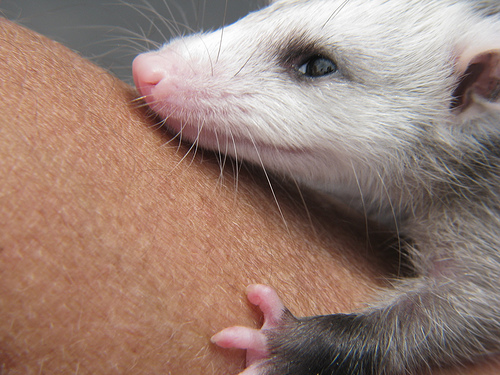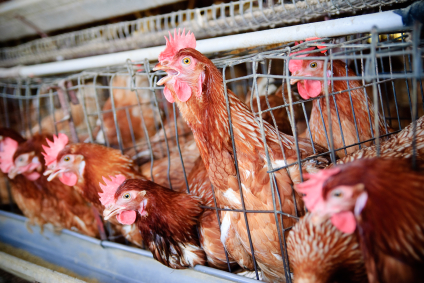In Meat Wagon, we round up the latest outrages from the meat and livestock industries.
————-
 Nasty, brutish, and short: the facts of life for hens in an egg factory. Moral of this story on inhumane practices in the egg industry: when a few huge companies dominate production of a commodity in a low-profit-margin industry, they zealously cut costs at every level of production. The key goal is to maximize output. Above a certain level, the company churns out a profit. Below that level, it loses cascading amounts of money for its shareholders.
Nasty, brutish, and short: the facts of life for hens in an egg factory. Moral of this story on inhumane practices in the egg industry: when a few huge companies dominate production of a commodity in a low-profit-margin industry, they zealously cut costs at every level of production. The key goal is to maximize output. Above a certain level, the company churns out a profit. Below that level, it loses cascading amounts of money for its shareholders.
If you happen to be a cog in the operation–say, a hen in an egg-laying shed with 300,000 other birds–life will be painful and short. And the end won’t be pretty.
To its everlasting discredit, the U.S. meat/livestock industry refuses to allow the media or the general public to enter its facilities. It hides its gruesome practices behind walls–and homilies: “All Rose Acre Farms hens are cared for to make sure all hens are happy at all times. Only a happy hen will lay eggs!” Rose Acre Farms is the nation’s second-largest egg producer. The Humane Society of the United States managed to infiltrate its Iowa facilities and document cruel and highly unsanitary practices. Thank God for HSUS.
 A section of Amazon rain forest being cleared for cow pasture. Photo courtesy Greenpeace/Daniel Beltrá. • In June of last year, Greenpeace came out with an excellent report on the Brazilian beef industry’s affect on deforestation: perhaps the single most urgent climate change issue.
A section of Amazon rain forest being cleared for cow pasture. Photo courtesy Greenpeace/Daniel Beltrá. • In June of last year, Greenpeace came out with an excellent report on the Brazilian beef industry’s affect on deforestation: perhaps the single most urgent climate change issue.
As I summarized at the time, the Brazil is already the globe’s leading exporter of both beef and leather. The government, cheered on by the World Bank, wants to see the country double its share in the global beef-products market in the next decade, as part of a push for export-led growth.
The Brazilian government has been investing billions of dollars in infrastructure and loan guarantees to meet that goal–even though “the cattle sector in the Brazilian Amazon is the largest driver of deforestation in the world, responsible for one in every eight hectares destroyed,” according to Greenpeace. Of course, the push for more beef production puts severe pressure on the rainforest, as ranchers expand pastures and hunt for new grazing land. Indeed, the government is literally investing in beef-processing infrastructure in the Amazon region.
At the time of the report, three huge players–Bertin, JBS, and Matrig–processed the great majority of Brazilian beef, and benefited directly from those investments. Since then, JBS has swallowed up Bertin, making it by far the biggest processor in Brazil. Meat Wagon readers will remember that JBS has become a heavyweight in the U.S. meat market–after a string of acquisitions in ’08 and ’09, JBS is our third-largest beef packer, second-largest poultry packer, and third-largest pork packer. Indeed, it’s combined global assets make it the largest meat producer in the world, larger even than U.S. behemoth Tyson.
JBS has always denied buying cattle from illegally deforested land, but in its report, Greenpeace proved that claim to be false. In October, JBS signed Greenpeace’s “Zero Deforestation Pledge,” promising to ensure that cattle it buys not come from deforested land. So, how’s that going? So far, not so well:
In a meeting on April 5th with Greenpeace, the major slaughterhouses of Brazil–including JBS/Bertin, Marfrig and Minerva–showed insufficient progress to comply with the first step in the Zero Deforestation Agreement they signed six months ago. Each of the companies reaffirmed their commitment to stopping deforestation of the Amazon by cattle ranchers, however, and asked for more time in order to be in compliance with the agreement.
• Leveling rain forest to create pasture for cattle production is clearly an idiotic practice. Rain forest ecosystems support a dizzying array of species (including humans). Large ruminants are not among them. Making rain forests hospitable to ruminants means obliterating rain forests–unleashing vast amounts of carbon, and sacrificing untold amounts of future carbon-sequestering capacity. Levelling rain forest for beef makes about as much sense as amputating your lungs and eating them for dinner.
However, the globe’s grasslands have long supported ruminants; and ruminants play a vital role in maintaining those ecosystems. So keeping cows on grass in, say, the prairies of Iowa–long since plowed up for corn–makes lots of sense. Which brings us to our next item: this crudely reported NPR segment on grass-fed vs. grain-fed beef.
I say, crudely reported, because the reporter doesn’t seem to understand that all cows start out on grass; the distinction hinges on whether they’re finished on grass or grain. She also shows no appetite to delve too deeply into just what grain-fed cows get in their rations. “The typical corn-fed cows eats just grain from a trough,” she declares, in that singsongy tone of voice favored by kindergarten teachers and many NPR presenters. If only it were true! But I guess discussion of antibiotics, industrial chicken manure, waste from ethanol factories, etc, would have ruined the happy-happy NPR-world tone of the piece.
The interesting part, though, is when she performs a blind taste test of grass-fed vs. corn-fed steaks for two NPR staffers. Both prefer the “more tender” grain-fed sample to the “meatier” grass-fed. Moral of the story: thirty or so years of cheap grain-fed beef has shaped the American palate and made people prize the tender quality of beef from animals that don’t exercise.




